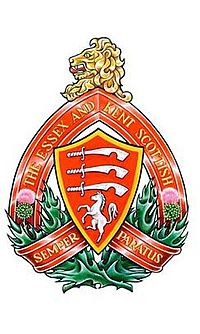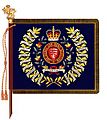Essex and Kent Scottish facts for kids
Quick facts for kids The Essex and Kent Scottish Regiment |
|
|---|---|

The cap badge of the Essex and Kent Scottish
|
|
| Active | 12 June 1885 - |
| Country | Canada |
| Branch | Primary Reserve |
| Type | Line infantry |
| Role | Light infantry |
| Size | One battalion |
| Part of | Royal Canadian Infantry Corps |
| Garrison/HQ | Windsor, Ontario |
| Nickname(s) | "The Detroit Scottish" |
| Motto(s) | Semper paratus (Latin for 'always ready') |
| March | "Highland Laddie", "A Hundred Pipers" |
| Engagements |
|
| Battle honours | See #Battle honours |
| Commanders | |
| Current commander |
LCol Gord Prentice |
| Colonel-in-Chief | Prince Michael of Kent |
| Insignia | |
| Tartan | Based upon the MacGregor |
The Essex and Kent Scottish is a special army group in Canada. It's like a part-time army unit, but they train hard! This group is part of the Canadian Army's Primary Reserve.
This regiment was created in 1954. It brought together two older army groups: The Essex Scottish Regiment and The Kent Regiment.
Prince Michael of Kent is their special leader, called the Colonel-in-Chief. Their main commander right now is Lieutenant-Colonel Gord Prentice. They have two main teams, called platoons. One is in Windsor, Ontario, and the other is in Chatham-Kent, Ontario.
Contents
How the Regiment Started
The Essex Scottish Regiment
The Essex Scottish Regiment started on June 12, 1885. It was first called the 21st Essex Battalion of Infantry. This group was made up of five smaller companies from Essex County. Major John Richardson was their first leader. This date marks the beginning of the Essex and Kent Scottish Regiment's long history.
Over the years, the name of this group changed a few times. In 1887, it became the 21st Battalion Essex Fusiliers. Then, in 1900, it was renamed the 21st Regiment Essex Fusiliers. Finally, in 1927, it became known as The Essex Scottish Regiment.
Before the First World War, this regiment didn't fight as a whole group. However, they trained to be ready for conflicts like the North-West Rebellion in 1885. In 1900, over 100 of their men volunteered to fight in the Second Boer War in South Africa. Only 16 were chosen to go. Sadly, two of these men did not return home.
The Kent Regiment
The army group in Kent County was called the 24th Kent Regiment. This group had been created and then stopped several times before 1901. It wasn't until January 1, 1901, that it became a permanent group. This happened because more soldiers were needed for the Second Boer War.
Their main office was in Chatham, Ontario. Seven of their men went to fight in the Boer War, and one of them did not come back. Like the Essex Fusiliers, the Kent Regiment also changed its name. In 1936, it became the Kent Regiment (MG), which meant it was a machine gun regiment. Later, in 1941, it was simply renamed The Kent Regiment.
Regiment's Journey Through Time
| Lineage chart | |||||||||||||||||||||||||||||||||||||||||||||||||||||||||||||||||||||||||||||||||||||||||||||||||||||||||||||||||||||||||||||||||||||||||||||||||||||||||||||||||||||||||||||||||||||||||||||||||||||||||||||||||||||||||||||||||||||||||||||||||||||||||||||||||||||||||||||||||||||||||||||||||||||||||||||||||||||||||||||||||||||||||||||||||||||||||||||||||||||||||||||||||||||||||||||||||||||||||||||||||||||||||||||||||||||||||||||||||||||||||||||||||||||||||||||||||||||||||||||||||||||||||||||||||||||||||||||||||||||||||||||||||||||||||||||||||||||||||||||||||||||||||||||||||||||||||||||||||||||||||||||||||||||||||||||||||||||||||||||||||||||||||||||||||||||||||||||||||||||||||||||||||||||||||||||||||||||||||||||||||||||||||||||||||||||||||||||||||||||||||||||||||||||||||||||||||||||||||||||||||||||||||||||||||||||||||||||||||||||||||||||||||||||||||||||||||||||||||||||||||||||||||||||||||||||||||||||||||||||||||||||||||||||||||||||||||||||||||||||||||||||||||||||||||||||||||||||||||||||||
|---|---|---|---|---|---|---|---|---|---|---|---|---|---|---|---|---|---|---|---|---|---|---|---|---|---|---|---|---|---|---|---|---|---|---|---|---|---|---|---|---|---|---|---|---|---|---|---|---|---|---|---|---|---|---|---|---|---|---|---|---|---|---|---|---|---|---|---|---|---|---|---|---|---|---|---|---|---|---|---|---|---|---|---|---|---|---|---|---|---|---|---|---|---|---|---|---|---|---|---|---|---|---|---|---|---|---|---|---|---|---|---|---|---|---|---|---|---|---|---|---|---|---|---|---|---|---|---|---|---|---|---|---|---|---|---|---|---|---|---|---|---|---|---|---|---|---|---|---|---|---|---|---|---|---|---|---|---|---|---|---|---|---|---|---|---|---|---|---|---|---|---|---|---|---|---|---|---|---|---|---|---|---|---|---|---|---|---|---|---|---|---|---|---|---|---|---|---|---|---|---|---|---|---|---|---|---|---|---|---|---|---|---|---|---|---|---|---|---|---|---|---|---|---|---|---|---|---|---|---|---|---|---|---|---|---|---|---|---|---|---|---|---|---|---|---|---|---|---|---|---|---|---|---|---|---|---|---|---|---|---|---|---|---|---|---|---|---|---|---|---|---|---|---|---|---|---|---|---|---|---|---|---|---|---|---|---|---|---|---|---|---|---|---|---|---|---|---|---|---|---|---|---|---|---|---|---|---|---|---|---|---|---|---|---|---|---|---|---|---|---|---|---|---|---|---|---|---|---|---|---|---|---|---|---|---|---|---|---|---|---|---|---|---|---|---|---|---|---|---|---|---|---|---|---|---|---|---|---|---|---|---|---|---|---|---|---|---|---|---|---|---|---|---|---|---|---|---|---|---|---|---|---|---|---|---|---|---|---|---|---|---|---|---|---|---|---|---|---|---|---|---|---|---|---|---|---|---|---|---|---|---|---|---|---|---|---|---|---|---|---|---|---|---|---|---|---|---|---|---|---|---|---|---|---|---|---|---|---|---|---|---|---|---|---|---|---|---|---|---|---|---|---|---|---|---|---|---|---|---|---|---|---|---|---|---|---|---|---|---|---|---|---|---|---|---|---|---|---|---|---|---|---|---|---|---|---|---|---|---|---|---|---|---|---|---|---|---|---|---|---|---|---|---|---|---|---|---|---|---|---|---|---|---|---|---|---|---|---|---|---|---|---|---|---|---|---|---|---|---|---|---|---|---|---|---|---|---|---|---|---|---|---|---|---|---|---|---|---|---|---|---|---|---|---|---|---|---|---|---|---|---|---|---|---|---|---|---|---|---|---|---|---|---|---|---|---|---|---|---|---|---|---|---|---|---|---|---|---|---|---|---|---|---|---|---|---|---|---|---|---|---|---|---|---|---|---|---|---|---|---|---|---|---|---|---|---|---|---|---|---|---|---|---|---|---|---|---|---|---|---|---|---|---|---|---|---|---|---|---|---|---|---|---|---|---|---|---|---|---|---|---|---|---|---|---|---|---|---|---|---|---|---|---|---|---|---|---|---|---|---|---|---|---|---|---|---|---|---|---|---|---|---|---|---|---|---|---|---|---|---|---|---|---|---|---|---|---|---|---|---|---|---|---|---|---|---|---|---|---|---|---|---|---|---|---|---|---|---|---|---|---|---|---|---|---|---|---|---|---|---|---|---|---|---|---|---|---|---|---|---|---|---|---|---|---|---|---|---|---|---|---|---|---|---|---|---|---|---|---|---|---|---|---|---|---|---|---|---|---|---|---|---|---|---|---|---|---|---|---|---|---|---|---|---|---|---|---|---|---|---|---|---|---|---|---|---|---|---|---|---|---|---|---|---|---|---|---|---|---|---|---|---|---|---|---|---|---|---|---|---|---|---|---|---|---|---|---|---|---|---|---|---|---|---|---|---|---|---|---|---|---|---|---|---|---|---|---|---|---|---|---|---|---|---|---|---|---|---|---|---|---|---|---|---|---|---|---|---|---|---|---|---|---|---|---|---|---|---|---|---|---|---|---|---|---|---|---|---|---|---|---|---|---|---|---|---|---|---|---|---|---|---|---|---|---|---|---|---|---|---|---|---|---|---|---|---|---|---|---|---|---|---|---|---|---|---|---|---|---|---|---|---|---|---|---|---|---|---|---|---|---|---|---|---|---|---|---|---|---|---|---|---|---|---|---|---|---|---|---|---|---|---|---|---|---|---|---|---|---|---|---|---|---|---|---|---|---|---|---|---|---|---|---|---|---|---|---|---|---|---|---|---|---|---|---|---|---|---|---|
|
|||||||||||||||||||||||||||||||||||||||||||||||||||||||||||||||||||||||||||||||||||||||||||||||||||||||||||||||||||||||||||||||||||||||||||||||||||||||||||||||||||||||||||||||||||||||||||||||||||||||||||||||||||||||||||||||||||||||||||||||||||||||||||||||||||||||||||||||||||||||||||||||||||||||||||||||||||||||||||||||||||||||||||||||||||||||||||||||||||||||||||||||||||||||||||||||||||||||||||||||||||||||||||||||||||||||||||||||||||||||||||||||||||||||||||||||||||||||||||||||||||||||||||||||||||||||||||||||||||||||||||||||||||||||||||||||||||||||||||||||||||||||||||||||||||||||||||||||||||||||||||||||||||||||||||||||||||||||||||||||||||||||||||||||||||||||||||||||||||||||||||||||||||||||||||||||||||||||||||||||||||||||||||||||||||||||||||||||||||||||||||||||||||||||||||||||||||||||||||||||||||||||||||||||||||||||||||||||||||||||||||||||||||||||||||||||||||||||||||||||||||||||||||||||||||||||||||||||||||||||||||||||||||||||||||||||||||||||||||||||||||||||||||||||||||||||||||||||||||||||
Important Connections
This regiment keeps the history of several older army groups alive. This is called "perpetuation."
War of 1812
The Essex and Kent Scottish remembers these groups from the War of 1812:
- 1st and 2nd Regiments of the Essex Militia
- 1st Regiment of the Kent Militia
- Loyal Kent Volunteers
- Loyal Essex Volunteers (Essex Rangers)
- Western Rangers (Caldwell's Rangers)
First World War
The Essex and Kent Scottish also remembers these groups from the First World War:
- 18th Battalion (Western Ontario), CEF
- 99th (Essex) Battalion, CEF
- 186th (Kent) Battalion, CEF
- 241st Battalion (Canadian Scottish Borderers), CEF
Regiment's History
First World War
At the start of the First World War in 1914, soldiers from the 21st Regiment Essex Fusiliers and 24th Kent Regiment began active duty. They helped protect local areas.
The 18th Battalion (Western Ontario), CEF was officially formed in November 1914. They sailed to Great Britain in April 1915 and arrived in France in September 1915. This battalion fought in France and Flanders as part of the 2nd Canadian Division until the war ended.
Other battalions, like the 99th, 186th, and 241st, were also formed. They went to Great Britain to help provide new soldiers for the Canadian forces fighting in the field. These battalions were later disbanded.
These groups fought in many major battles. Some of these include:
- Ypres in 1915 and 1917
- Festubert in 1915
- Mount Sorrel
- Somme in 1916
- Vimy in 1917
- Passchendaele
- Amiens
- Hindenburg Line
- Cambrai 1918
- The push towards Mons
Second World War
During the Second World War, The Essex Scottish Regiment joined active service in September 1939. They went to Great Britain in July 1940.
This battalion took part in the difficult raid on Dieppe in France on August 19, 1942. The Essex Scottish Regiment started the attack with 553 soldiers. After the battle, 530 of their men were hurt, captured, or killed. Many soldiers were taken prisoner. After Dieppe, the Essex Scottish spent a lot of time rebuilding their strength.
The unit returned to France in July 1944. They helped the British 2nd Army in Normandy. They also helped advance along the coast with the Canadian 1st Army, even helping to free Dieppe. The division fought hard in the Netherlands in late 1944 and in the final attacks of 1945.
Some of the battles the Essex Scottish fought in were:
- Bourguebus Ridge
- Falaise
- The Scheldt
- Woensdrecht
- South Beveland
- The Rhineland
- The Hochwald
- Xanten
- Groningen
- Oldenburg
The Kent Regiment (Machine Gun) also joined active service in May 1940. They served in Canada as part of the 8th Canadian Infantry Division. This battalion was later disbanded in 1946.
Joining Forces in 1954
On July 8, 1954, the Essex Scottish Regiment and the Kent Regiment were training together. They found out they would become one unit. This officially happened on October 1, 1954, forming The Essex and Kent Scottish Regiment.
At first, the new regiment had two main groups, called battalions. The first battalion was in Windsor, and the second was in Chatham. In 1964, the Canadian Forces decided to make some changes. So, on March 31, 1965, the two battalions joined into one. This is how the regiment is still set up today.
When the two groups first joined, there were some challenges. They had too many members, so some officers had to move to other units. They also had to decide who would lead the new group. It was decided that future leaders would come from Windsor, where the main office would be. A big event that helped bring the two groups together was showing off their first new flags, called "colours." This happened in Windsor, Ontario, on June 5, 1955.
Modern Day Missions
Today, The Essex and Kent Scottish Regiment is still an active part of the Canadian army. Many of its soldiers have gone on United Nations peacekeeping missions. Over forty members have also served in the recent conflict in Afghanistan. Soldiers from the regiment have also been sent to Lebanon (Operation Jade), Ukraine (Operation Unifier), Poland, and Latvia (Operation Reassurance).
On May 13, 2023, in Windsor, Prince Michael of Kent gave the regiment new flags. These flags were special because they were the first to include honors for the War of 1812 and Afghanistan. The next day, Prince Michael was there when the old flags were put away in a church in Chatham.
Friends and Partners
The Essex and Kent Scottish Regiment has special connections with other army groups. These are called "alliances."
 United Kingdom - The Princess of Wales's Royal Regiment (Queen's and Royal Hampshires)
United Kingdom - The Princess of Wales's Royal Regiment (Queen's and Royal Hampshires) United Kingdom - The Royal Anglian Regiment
United Kingdom - The Royal Anglian Regiment
Battle Honors
Battle honors are special awards given to military units for their bravery and success in battles. The ones in bold are shown on the regiment's flag.
War of 1812
First World War
- Ypres, 1915, '17
- Festubert, 1915
- Mount Sorrel
- Somme, 1916, '18
- Flers–Courcelette
- Thiepval
- Ancre Heights
- Arras, 1917, '18
- Vimy, 1917
- Hill 70
- Passchendaele
- Amiens
- Scarpe, 1918
- Hindenburg Line
- Canal du Nord
- Cambrai, 1918
- Pursuit to Mons
- France and Flanders, 1915–18
Second World War
- Dieppe
- Bourguébus Ridge
- St. André-sur-Orne
- Falaise
- Falaise Road
- Clair Tizon
- Forêt de la Londe
- The Scheldt
- Woensdrecht
- South Beveland
- The Rhineland
- Goch–Calcar Road
- The Hochwald
- Xanten
- Twente Canal
- Groningen
- Oldenburg
- North-West Europe, 1942, 1944–1945
War in Afghanistan
- Afghanistan
Heroes of the Regiment
These soldiers from the regiment received the Victoria Cross, a very high award for bravery:
- L/Sgt Ellis Wellwood Sifton
- Major Frederick Albert Tilston
Cadet Programs
There are four cadet groups connected to the regiment. Cadets are young people who learn about the military and develop leadership skills.
- 59 Legion Highlander Royal Canadian Army Cadet Corps (Chatham-Kent, Ontario)
- 1086 Walkerville Army Cadet Corps (Windsor, Ontario)
- 2715 Metropolitan Legion Royal Canadian Army Cadet Corps (Windsor, Ontario)
- 2918 South Essex Scottish Royal Canadian Army Cadet Corps (Kingsville, Ontario)
Regiment Buildings
These are the main buildings where the regiment trains and works.
| Site | Location | What it is |
|---|---|---|
| Windsor Armouries Maj FA Tilston VC Armoury 4007 Sandwich Street, Windsor Ontario, N9C 1C3 |
Windsor, Ontario | This building houses The Essex and Kent Scottish (1st Platoon), along with other military and police training groups. It has a shooting range, a rappel tower, and other training areas. |
| Col. E.M. Ansell, OBE, MC, VD Armoury 280 Bloomfield Road, Chatham, Ontario, N7M 2P0 |
Chatham, Ontario | This building houses The Essex and Kent Scottish (2nd Platoon). |
| Former Home: Maj FA Tilston VC Armoury 353 Freedom Way, Windsor |
Windsor, Ontario | This old building was used by The Essex and Kent Scottish until 2004. It's a two-story red brick building with a tall tower. Now, the University of Windsor owns it. |
See also



